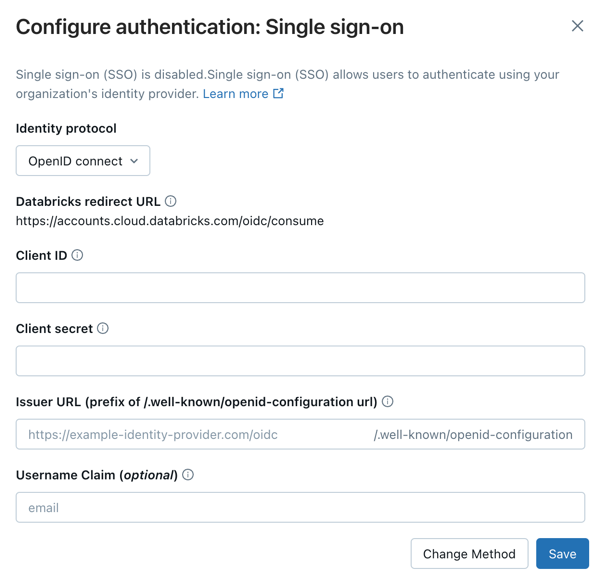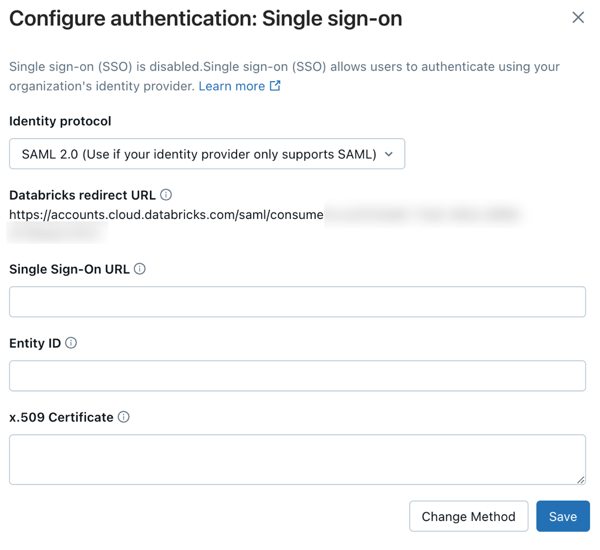SSO to Databricks with Microsoft Entra ID
This page shows how to configure Microsoft Entra ID as the identity provider for single sign-on (SSO) in your Databricks account. Microsoft Entra ID supports both OpenID Connect (OIDC) and SAML 2.0. To sync users and groups from Microsoft Entra ID, see Sync users and groups from your identity provider using SCIM.
To prevent getting locked out of Databricks during single sign-on testing, Databricks recommends keeping the account console open in a different browser window. You can also configure emergency access with security keys to prevent lockout. See Emergency access to prevent lockouts.
Enable Microsoft Entra ID SSO using OIDC
-
As an account admin, log in to the account console and click the Settings icon in the sidebar.
-
Click the Authentication tab.
-
Next to Authentication, click Manage.
-
Choose Single sign-on with my identity provider.
-
Click Continue.
-
Under Identity protocol, select OpenID Connect.
-
On the Authentication tab, make note of the Databricks Redirect URL value.
-
In another browser tab, create a Microsoft Entra ID application:
- Log in to the Azure portal as an administrator.
- In the left navigation, click Microsoft Entra ID.
- Click App registrations > New registration.
- Enter a name.
- Under Supported account types choose: Accounts in this organizational directory only.
- Under Redirect URI, choose web and paste the Databricks Redirect URL value.
- Click Register.
-
Gather the required information from the Microsoft Entra ID application:
- Under Essentials, copy the Application (client) ID.
- Click Endpoints.
- Copy the URL under OpenID Connect metadata document
- In the left pane, click Certificates & secrets.
- Click + New client secret.
- Enter a description and choose an expiration.
- Click Add.
- Copy the secret value.
-
Return to the Databricks account console Authentication page and enter values you copied from the identity provider application to the Client ID, Client secret, and OpenID issuer URL fields. Remove the
/.well-known/openid-configurationending from the URL.You can specify query parameters by appending them to the issuer URL, for example
{issuer-url}?appid=123. -
Optionally, enter the name of a claim in the Username claim if you want to use a claim other than
emailas users' Databricks usernames. For more information, see Customize a claim to use for your account's usernames.
-
Click Save.
-
Click Test SSO to validate that your SSO configuration is working properly.
-
Click Enable SSO to enable single sign-on for your account.
-
Test account console login with SSO.
Configure unified login and add users to Databricks
After you configure SSO, Databricks recommends that you configure unified login and add users to your account using SCIM provisioning.
-
Configure unified login
Unified login allows you to use the account console SSO configuration in your Databricks workspaces. If your account was created after June 21, 2023 or you did not configure SSO before December 12, 2024, unified login is enabled on your account for all workspaces and it cannot be disabled. To configure unified login, see Enable unified login.
-
Add users to Databricks
-
Enable JIT provisioning
Databricks recommends enabling JIT to automatically add users to Databricks when they first log in using SSO. JIT provisioning is on by default for accounts created after May 1, 2025 when SSO is configured. See Automatically provision users (JIT).
-
Configure SCIM provisioning
Databricks recommends using SCIM provisioning to sync users and groups automatically from your identity provider to your Databricks account. SCIM streamlines onboarding a new employee or team by using your identity provider to create users and groups in Databricks and give them the proper level of access. See Sync users and groups from your identity provider using SCIM.
-
Enable Microsoft Entra ID SSO using SAML
Follow these steps to create a non-gallery Azure portal SAML application for use with Databricks account console.
-
As an account admin, log in to the account console and click the Settings icon in the sidebar.
-
Click the Authentication tab.
-
Next to Authentication, click Manage.
-
Choose Single sign-on with my identity provider.
-
Click Continue.
-
Under Identity protocol, select SAML 2.0.
-
On the Authentication tab, make note of the Databricks Redirect URL value.

-
In another browser tab, create a Microsoft Entra ID application:
- Log in to Azure portal as an administrator.
- In the left navigation, click Microsoft Entra ID > Enterprise applications. The All applications pane opens and displays a random sample of the applications in your Microsoft Entra ID tenant.
- Click New application.
- Click Create your own application.
- Enter a name.
- Under What are you looking to do with your application? choose Integrate any other application you don't find in the gallery.
-
Configure the Microsoft Entra ID application:
-
Click Properties.
-
Set Assignment required to No. Databricks recommends this option, which allows all users to sign in to the Databricks account. Users must have access to this SAML application to log into your Databricks account using SSO.
-
In the application's properties pane, click Set up single sign on.
-
Click SAML to configure the application for SAML authentication. The SAML properties pane appears.
-
Next to Basic SAML configuration, click Edit.
-
Set Entity ID to the Databricks SAML URL you got from the Databricks SSO configuration page.
-
Set Reply URL to the Databricks SAML URL you got from the Databricks SSO configuration page.
-
Next to SAML Signing Certificate, click Edit.
-
In the Signing Option drop-down list, select Sign SAML response and assertion and set the Signing Algorithm to SHA-256 for enhanced security.
-
In Attributes & Claims, click Edit.
-
Set the Unique User Identifier (Name ID) field to
user.mail. -
Under SAML Certificates, next to Certificate (Base64), click Download. The certificate is downloaded locally as a file with the
.cerextension. -
Open the
.cerfile in a text editor and copy the file contents. The file is the entire x.509 certificate for the Microsoft Entra ID SAML application.important- Do not open it using the macOS keychain, which is the default application for that file type in macOS.
- The certificate is sensitive data. Use caution about where to download it. Delete it from local storage as soon as possible.
-
In the Azure portal, under Set up Microsoft Entra ID SAML Toolkit, copy and save the Login URL and Microsoft Entra ID Identifier.
-
-
Configure Databricks in the Databricks account console SSO page.
- Set Single Sign-On URL to the Microsoft Entra ID field that was called Login URL.
- Set Identity Provider Entity ID to the Microsoft Entra ID field that was called Microsoft Entra ID Identifier.
- Set x.509 Certificate to the Microsoft Entra ID x.509 certificate, including the markers for the beginning and end of the certificate.
- Click Save.
- Click Test SSO to validate that your SSO configuration is working properly.
- Click Enable SSO to enable single sign-on for your account.
- Test account console login with SSO.
Configure unified login and add users to Databricks
After you configure SSO, Databricks recommends that you configure unified login and add users to your account using SCIM provisioning.
-
Configure unified login
Unified login allows you to use the account console SSO configuration in your Databricks workspaces. If your account was created after June 21, 2023 or you did not configure SSO before December 12, 2024, unified login is enabled on your account for all workspaces and it cannot be disabled. To configure unified login, see Enable unified login.
-
Add users to Databricks
-
Enable JIT provisioning
Databricks recommends enabling JIT to automatically add users to Databricks when they first log in using SSO. JIT provisioning is on by default for accounts created after May 1, 2025 when SSO is configured. See Automatically provision users (JIT).
-
Configure SCIM provisioning
Databricks recommends using SCIM provisioning to sync users and groups automatically from your identity provider to your Databricks account. SCIM streamlines onboarding a new employee or team by using your identity provider to create users and groups in Databricks and give them the proper level of access. See Sync users and groups from your identity provider using SCIM.
-
Customize a claim to use for your account's usernames
By default, usernames in Databricks are represented as a user's email address. If you would like to assign usernames using a different value, you can configure a new claim in your Microsoft Entra ID account.
- Log in to Azure portal as an administrator.
- In the left navigation, click Microsoft Entra ID.
- Click + Add > Enterprise application.
- Under Browse Microsoft Entra Gallery, click Create your own application.
- Enter a name for your application.
- In Supported account types, select Accounts in this organizational directory only (Single tenant).
- Under Redirect URI (optional), select Web and enter
https://accounts.cloud.databricks.com/oidc/consume. - Click Register.
- Go to the created application's Overview page and take note of the Application (client) ID.
- In the Endpoints tab, note the OpenID Connect metadata document URL.
- In the sidebar, under Manage, click Certificates & secrets.
- Click + New client secret.
- Enter a name and an expiration date for the secret.
- Click Add and note the secret's value.
- In the sidebar, under Manage, click Manifest.
- Edit the manifest to set
"acceptMappedClaims": true. - Click Save.
- Return to the application's Overview page.
- In the sidebar, under Manage, click Single sign-on.
- In Attributes & Claims, click Edit.
- Click Add new claim.
- Enter a Name for the claim. This is the name you will enter in the Username claim field of your Databricks SSO configuration.
- For Source attribute, select the desired Microsoft Entra ID attribute for this claim.
- Click Save.
When configuring SSO in the Databricks account console, enter:
- The Client ID from step 9.
- The Client secret from step 14.
- The OpenID issuer URL from step 10 (enter only up to
/v2.0and exclude/.well-known/openid-configuration). - The Username claim name from step 21.
Click Save and Test SSO to validate your configuration and then clicks Enable SSO.